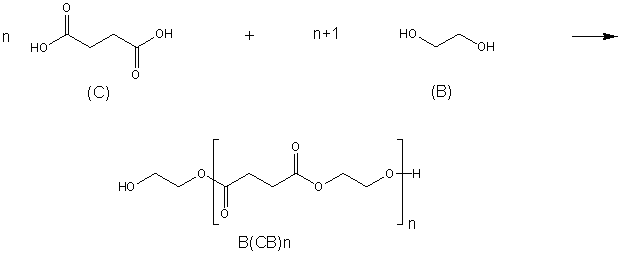

 
|
|
|
|
|
||
| CEPA Registry Environmental Law Enforcement Site Map | |

|
|
New Substances Program Advisory Note 2006-01New Substances Notification Technical Guidance Document:
|

A) Isophorone diisocyanate |
B) Ethylene glycol |

C) 1,4-butanedioic acid |
Example 1 - The reaction scheme to obtain Polymer 1 is:


The final product, Polymer 1, has the structure CB(AB)nC, where component C is derived from a diacid monomer. Because it does not contain reactive groups of concern, it may meet the RRR polymer criteria. 1
Example 2 - The reaction scheme to obtain Polymer 2 from the same three monomers is:


Polymer 2 has the structure AB(CB)nA and contains unreacted isocyanates, which are reactive groups of concern. Therefore, this polymer may not meet the RRR polymer criteria. 2
1 For Polymer 1 to be deemed an RRR polymer, it must meet all other criteria indicated in Section 9 of the Regulations.
2 For Polymer 2 to be deemed an RRR polymer, it must meet all other criteria indicated in Section 9 of the Regulations.
The reaction scheme includes both monomer and reactant information and a sequence description.
The notifier must provide a table of the chemical identities of all monomers, pre-polymers, and reactants along with their CAS Registry number, molecular weight (Mw), percent by weight (% by weight), and relative number of moles. Each monomer, pre-polymer, and reactant should be assigned an identifier for use in the sequence description.
| Identifiers | Monomers and Reactants | CAS no. | Mw | % by weight | Relative no. of moles |
|---|---|---|---|---|---|
| A | Cyclohexane, 5-isocyanato-1-(isocyanatomethyl)-1,3,3-trimethyl- | 4098-71-9 | 222 | 2.52 | 11 |
| B | Poly(oxy-1,2-ethanediyl), a-hydro-w-hydroxy- | 25322-68-3 | 7850 | 97.22 | 12 |
| C | Hexane, 1-isocyanato- | 2525-62-4 | 127 | 0.002 | 2 |
EITHER
a) Provide the order and description of each step, including the nature of the reactions and the identifiers for all monomers, reactants, and intermediates. For example:
Step 1: A + B ![]() Intermediate AB (Polyurethane formation)
Intermediate AB (Polyurethane formation)
Step 2: Intermediate AB + C ![]() Final Product (Urethane end-cap formation)
Final Product (Urethane end-cap formation)
AND/OR
b) Provide a sequencing description that uses structural formulae and includes the order and nature of the reactions and the identifiers for all monomers, reactants, and intermediates. For example:


Under the Regulations, the reaction scheme is a mandatory information requirement for all RRR polymers that are notified under Schedule 9. However, if the notified substance meets the polyester-exemption criteria (paragraph 9(c) of the Regulations), a reaction scheme does not have to be submitted. Some polyester polymers are exempt if they are manufactured from a list of reactants outlined in Schedule 8 of the Regulations.
In addition, a reaction scheme is not required for non-RRR polymers.
If a polymer meets the RRR polymer criteria for number-average molecular weight and oligomer content, and no functional groups of concern are present, the notifier may request a waiver of the reaction-scheme requirement under paragraph 81(8)(a) of the Act. The waiver request must be accompanied by an appropriate justification. Its acceptability will be evaluated by scientists from the New Substances Program.
If a notifier is unable to submit a complete reaction scheme, there are two possible scenarios:
Please note that non-RRR status requires that additional information requirements must be met.
If the notifier cannot access the reaction scheme because it is considered to be confidential by a foreign supplier, the information must be supplied directly to the New Substances Program by the Foreign Supplier. The confidential reaction scheme will be identified as a “Foreign Supplier Submission” (refer to Section 5.2 of the Guidelines for the Notification and testing of New Substances: Chemicals and Polymers, Version 2005 for further explanations).
For additional information or documentation regarding the New Substances Notification Regulations, please visit the New Substances Website at http://www.ec.gc.ca/substances/nsb/eng/index_e.htm.
Original signed by
Bernard Madé
Director
New Substances Division
Environment Canada
Signed on May 24, 2006
|
Disclaimer: Although care has been taken to ensure that the information found on this website accurately reflects the requirements prescribed, you are advised that, should any inconsistencies be found, the legal documents, printed in the Canada Gazette, will prevail. |
|
The Green LaneTM, Environment Canada's World Wide Web site
|
||
|
|
||
|
|
||